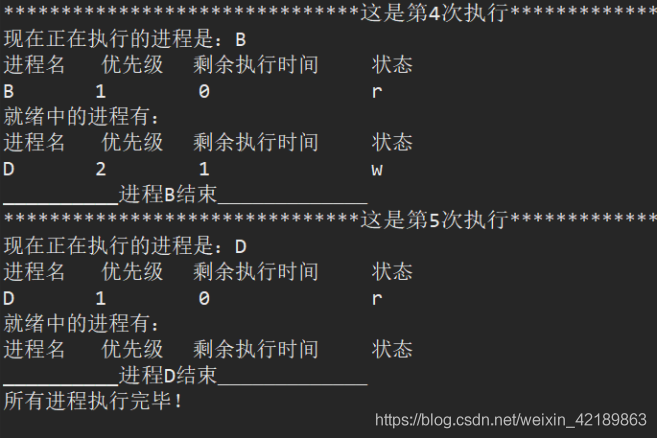【实验目的】
- 掌握进程控制块的作用和实现技术;
- 熟悉操作系统的进程调度算法及实现方法。
【实验原理】
每个进程有一个进程控制块(PCB)表示。进程控制块可以包含如下信息:进程名、优先数、到达时间、需要运行时间、已用CPU时间、进程状态等等。
进程的优先数及需要的运行时间可以事先人为地指定(也可以由随机数产生)。进程的到达时间为进程输入的时间。
进程的运行时间以时间片为单位进行计算。
每个进程的状态可以是就绪 W(Wait)、运行R(Run)、或完成F(Finish)三种状态之一。
就绪进程获得 CPU后都只能运行一个时间片。用已占用CPU时间加1来表示。
如果运行一个时间片后,进程的已占用 CPU时间已达到所需要的运行时间,则撤消该进程,如果运行一个时间片后进程的已占用CPU时间还未达所需要的运行时间,也就是进程还需要继续运行,此时应将进程的优先数减1(即降低一级),然后把它插入就绪队列等待CPU。
每进行一次调度程序都打印一次运行进程、就绪队列、以及各个进程的 PCB,以便进行检查。
重复以上过程,直到所要进程都完成为止。
【代码(Java实现)】
扫描二维码关注公众号,回复:
11457604 查看本文章


首先是一个辅助类:
public class Shuru {
String name;
int Super;
int zxTime;
int ddtime;//到达时间
int runtime;//剩余执行时间
String zt;//进程状态
}正式代码:
import java.util.Scanner;
public class Jincheng {
Scanner s = new Scanner(System.in);
public void begin1(int n) {
Scanner sr[] = new Scanner[n];
Shuru shuru[] = new Shuru[n];
int yxj[] = new int[n];
int zzxtime = 0;// 总执行时间
for (int i = 0; i < n; i++) {
System.out.println("进程" + (i + 1) + "信息输入:");
shuru[i] = new Shuru();
sr[i] = new Scanner(System.in);
System.out.print("请输入进程名:");
shuru[i].name = sr[i].nextLine();
System.out.print("请输入优先级:");
shuru[i].Super = sr[i].nextInt();
yxj[i] = shuru[i].Super;// 每次将优先级传给数组
System.out.print("请输入执行时间:");
shuru[i].zxTime = sr[i].nextInt();
System.out.print("请输入到达时间:");
shuru[i].ddtime=sr[i].nextInt();
zzxtime += shuru[i].zxTime;
shuru[i].runtime = shuru[i].zxTime;
}
System.out.println("***************************************");
for (int i = 0; i < zzxtime; i++) {
System.out.println("*******************************这是第"+(i+1)+"次执行*****"
+ "***************************************");
sort(shuru);// 将优先级进行排序
shuru[n - 1].Super -= 1;// 优先级减一
shuru[n - 1].runtime = shuru[n - 1].runtime - 1;// 剩余执行次数减一
System.out.println("现在正在执行的进程是:" + shuru[n - 1].name);
System.out.println("进程名\t 优先级 \t 剩余执行时间 \t状态");
shuru[n-1].zt="r";
show(shuru[n - 1]);
System.out.println("就绪中的进程有:");
System.out.println("进程名\t 优先级 \t 剩余执行时间\t状态");
for (int j = 0; j < n - 1; j++) {
if (shuru[j].runtime != 0 && shuru[j].Super != 0) {
for (int k = j; k < n - 1; k++) {
shuru[k].zt="w";
show(shuru[k]);
break;
}
}
}
if (shuru[n - 1].runtime == 0) {// 如果剩余执行次数为0,进程结束
System.out.println("__________进程" + shuru[n - 1].name + "结束_____________");
shuru[n - 1].Super = 0;// 如果一个进程执行完毕,将它的优先级置零
}
}
}
public void sort(Shuru shuru[]) {// 比较优先级
for (int i = 1; i <= shuru.length; i++) {// 计数,第几轮比较
for (int j = 0; j < shuru.length - i; j++) {// 注意这一步,第一趟比较length次,第二趟比较length-1次,以此类推
if (shuru[j].Super > shuru[j + 1].Super) {
Shuru t = shuru[j];
shuru[j] = shuru[j + 1];
shuru[j + 1] = t;// 交换
}
}
}
}
public void sort1(Shuru shuru[]) {//比较到达时间
for (int i = 1; i <= shuru.length; i++) {// 计数,第几轮比较
for (int j = 0; j<shuru.length - i; j++) {// 注意这一步,第一趟比较length次,第二趟比较length-1次,以此类推
if (shuru[j].ddtime >shuru[j + 1].ddtime) {
Shuru t = shuru[j];
shuru[j] = shuru[j + 1];
shuru[j + 1] = t;// 交换
}
}
}
}
public void begin2(int n) {
Scanner sr[] = new Scanner[n];
Shuru shuru[] = new Shuru[n];
int yxj[] = new int[n];
int zzxtime = 0;// 总执行时间
for (int i = 0; i < n; i++) {
System.out.println("进程" + (i + 1) + "信息输入:");
shuru[i] = new Shuru();
sr[i] = new Scanner(System.in);
System.out.print("请输入进程名:");
shuru[i].name = sr[i].nextLine();
System.out.print("请输入执行时间:");
shuru[i].zxTime = sr[i].nextInt();
System.out.print("请输入到达时间:");
shuru[i].ddtime=sr[i].nextInt();
zzxtime += shuru[i].zxTime;
shuru[i].runtime = shuru[i].zxTime;
}
int count=0;
for(int i=0;i<zzxtime;i++) {
System.out.println("*******************************"
+ "**这是第"+(i+1)+"次执行**************************************");
shuru[count].runtime = shuru[count].runtime - 1;// 剩余执行次数减一
sort1(shuru);
System.out.println("现在正在执行的进程是:" + shuru[count].name);
System.out.println("进程名\t 剩余执行时间\t 到达时间\t\t状态");
shuru[count].zt="r";
show1(shuru[count]);
System.out.println("就绪中的进程有:");
System.out.println("进程名\t 剩余执行时间 \t到达时间\t\t状态");
for(int j=count+1;j<n;j++) {
shuru[j].zt="w";
show1(shuru[j]);
}
if (shuru[count].runtime == 0) {// 如果剩余执行次数为0,进程结束
System.out.println("__________进程" + shuru[count].name + "结束_____________");
count++;
}
}
}
public void show(Shuru shuru) {
System.out.println(shuru.name + "\t" + shuru.Super + "\t " + shuru.runtime+"\t\t"+shuru.zt);
}
public void show1(Shuru shuru) {
System.out.println(shuru.name + "\t" + shuru.runtime+"\t\t"+shuru.ddtime+"\t\t"+shuru.zt);
}
public static void main(String[] args) {
Jincheng j = new Jincheng();
Scanner s1 = new Scanner(System.in);
System.out.print("请输入进程数目:");
int n = s1.nextInt();
System.out.println("请输入你要选择的调度算法:(1 最高优先数优先;2 先来先服务)");
int choice=s1.nextInt();
if(choice==1) {
j.begin1(n);
}else if(choice==2) {
j.begin2(n);
}
else {
System.out.println("输入错误!请重新输入!");
}
System.out.println("所有进程执行完毕!");
}
}【结果截图】



还可以选择先来先服务:



转载请注明出处~我是一个有梦想的baby girl!